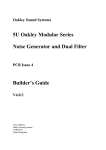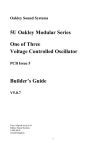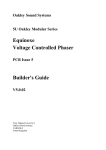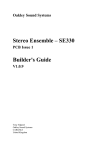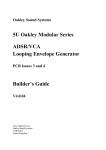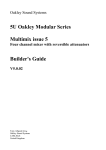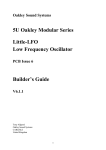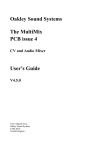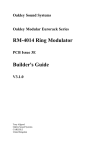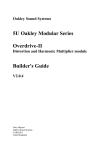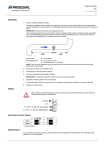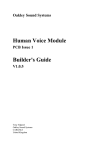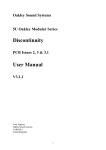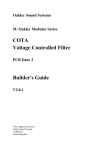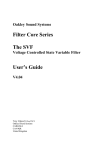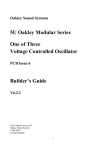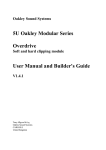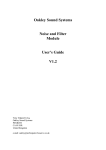Download Discontinuity issue 3 Builder`s Guide
Transcript
Oakley Sound Systems 5U Oakley Modular Series Discontinuity PCB Issue 3 & Issue 3.1 Builder's Guide V3.1.1 Tony Allgood Oakley Sound Systems CARLISLE United Kingdom 1 Introduction This is the Builder's Guide for the issues 3 and 3.1 Discontinuity 5U module from Oakley Sound. In this document you will find a basic introduction to the boards, a full parts list for the components needed to populate the boards and a list of the various interconnections. For the User Manual, which contains an overview of the operation of the unit and the calibration procedure, please visit the main project webpage at: http://www.oakleysound.com/discon.htm For general information regarding where to get parts and suggested part numbers please see our useful Parts Guide at the project webpage or http://www.oakleysound.com/parts.pdf. For general information on how to build our modules, including circuit board population, mounting front panel components and making up board interconnects please see our generic Construction Guide at the project webpage or http://www.oakleysound.com/construct.pdf. The prototype issue 2 Discontinuity fitted to a natural finish Schaeffer panel in the MOTM format. Issue 3 is almost identical. Note the use of the optional pot and socket boards to make the wiring up of the many sockets, switches and pots much easier. 2 The Issue 3 and Issue 3.1 Discontinuity PCB set The main printed circuit board (PCB) is 113 mm (depth) x 143 mm (height) in size. All three boards use double sided copper traces and have through plated holes. The solder pads are large and are easy to solder and de-solder if necessary. They have a high quality solder mask on both sides for easier soldering, and have clear legending on the component side. If you are building the standard design there are no components mounted off the boards except for the switches and LED. All other components including sockets and pots are soldered directly to the boards. Prior to 2004 many Oakley modules had the sockets, switches and extra pots wired to the board by individual wires. This module allows all the socket wiring to be done via the socket PCB and three MTA solderless or Molex connections. If you are building this module in the standard Oakley format this new system will reduce assembly time and possible wiring errors. Some people will wish to use this Oakley design in a non standard format, such as fitting it to another manufacturer’s rack or one of their own invention. This is perfectly easy to do. Simply do not use the socket board and wire the main board to the sockets as per usual. I have laid the board out to accept 0.1” headers for each additional pot and switch. I have provided space for four of the control pots on the main PCB, whilst the other four pots are fitted to their own board. If you use the specified pots and brackets, the PCBs can be held firmly to the panel without any additional mounting procedures. The pot spacing is 1.625” and is the same as vertical spacing of the MOTM modular synthesiser. The first run of issue 3 Discontinuity boards have a tracking error which was corrected with the release of issue 3.1. In the earlier issue 3 boards the positive power supply to the comparator, U2, and associating decoupling capacitor is connected to the +5V and not the +15V as required. Before using an issue 3 module the PCB must be first modified. A track needs to be cut and a small strapping lead fitted. This is a relatively simple job and it can be done neatly enough so that the overall appearance of the module is not detrimentally affected. The details of this modification are given later in this document. Once modified an issue 3 board will behave identically to an issue 3.1. The whole project takes around 3 to 4 hours to build and test. 3 Discontinuity issue 3 and issue 3.1 Parts List For general information regarding where to get parts and suggested part numbers please see our useful Parts Guide at the project webpage or http://www.oakleysound.com/parts.pdf. The components are grouped into values, the order of the component names is of no particular consequence. A quick note on European part descriptions. R is shorthand for ohm. K is shorthand for kiloohm. R is shorthand for ohm. So 22R is 22 ohm, 1K5 is 1,500 ohms or 1.5 kilohms. For capacitors: 1uF = one microfarad = 1000nF = one thousand nanofarad. To prevent loss of the small ‘.’ as the decimal point, a convention of inserting the unit in its place is used. eg. 4R7 is a 4.7 ohm, 4K7 is a 4700 ohm resistor, 6n8 is a 6.8 nF capacitor. Resistors All resistors, except were stated, are 5% carbon 1/4W although 1% metal film types are recommended. Components designated as 1% should be 0.25W 1% metal film or better. 22R 47R 150R 330R 1K 1K5 2K2 4K7 6K8 10K, 1% metal film 10K 15K 22K 24K 47K 68K 82K 100K 150K 330K 390K 1M R13, R26, R46 R50 R7, R25, R84 R69, R68, R67, R70 R52, R45, R44, R79 R3, R23, R24 R17, R41, R38 R27, R47 R10, R22 R78, R77, R75, R76 R5, R9, R21, R57, R74 R73, R39, R64, R51 R2, R14, R36, R1, R65, R42, R71, R43, R34, R32, R53 R16, R40 R28, R4, R81, R12, R11, R30, R29, R31, R61, R63, R59, R60, R58, R62, R56, R55 R20, R83 R37, R15, R54 R48, R49, R18, R19, R33, R35 R82 R80 R72, R66 R8, R6 4 Capacitors 12pF or 15pF 2.5mm C0G ceramic 33pF 2.5mm C0G ceramic 100pF 2.5mm C0G ceramic C24 C5, C15, C25 C1, C31 100nF, 63V multilayer axial ceramic C9, C2, C14, C20, C21, C17, C19, C11, C4, C3, C18, C26, C10, C16, C30, C27, C8 2u2, 63V electrolytic 33uF, 35V electrolytic 47uF, 35V electrolytic C22, C23, C28, C29 C13, C6, C7 C12 Discrete Semiconductors 1N4148 signal diode 5V1 zener diode 1N5819 Schottky diode BC560 PNP transistor 5mm red/green bi-colour LED D9, D7, D8, D2, D1, D12, D3, D4, D5, D6, D13, D14, D15, D16 D11, D10 D17, D18 Q1, Q3 LED Integrated Circuits 4558 dual bi-polar op-amp U1 78L05 +5V 100mA regulator U14 79L05 -5V 100mA regulator U15 TL072 dual J-FET op-amp U3, U4, U5, U6, U9, U10, U12, U13 LF412CN dual J-FET op-amp U7 DG403 dual SPDT analogue switch U8 LM13700 dual OTA U11 LM2903 dual low power comparator U2 IC sockets are to be recommended. You need ten 8-pin and two 16-pin DIL sockets. Trimmers (preset) resistors 100K, 6mm cermet trimmer 100K multiturn cermet trimmer OFF1, OFF2 ZERO, UNITY 5 Pots (Main board) 47K or 50K linear 16mm Alpha Three pot brackets DISCON, VOLUME, FOLD, THRESH Pots (Pot board) 47K or 50K linear 16mm Alpha Three pot brackets DIS CV, OFFSET, FLD CV, THR CV Miscellaneous Ferrite bead axial L2, L1 6-way 0.1” (2.54mm) jumper 4-way 0.1” (2.54mm) jumper OFF/TRK, CVD/POL ie. 2 off CVF/CVT ie. 1 off MTA156 4 way header MTA100 6-way header PSU – Oakley/MOTM power supply PWR – Synthesizers.com power supply 0.1” 2-way header 0.1” 3-way header 0.1” 4-way header 0.1” 5-way header LED – Optional LED wiring method. SCKT (pot board), SCKT (socket board) SKT-BOT (main board), SKT-BOT (socket board) SKT-TOP (main board), SKT-TOP (socket board) 0.1” 2-way housing 0.1” 3-way housing 0.1” 4-way housing 0.1” 5-way housing LED – Optional LED wiring method. SCKT (pot board), SCKT (socket board) SKT-BOT (main board), SKT-BOT (socket board) SKT-TOP (main board), SKT-TOP (socket board) Hook up wire to suit connectors Uninsulated tinned copper wire 2 metres 6 off 60mm pieces for wiring the switches Other panel components Clear LED lens clip & securing ring SPDT On-On switch SPDT On-Off-On switch 1/4” Switchcraft 112APC sockets Knobs LED TRK/OPP POS/NEG Eight sockets Eight to suit 6 – see 'Connections' – see 'Connections' Issue 3 PCB Modifications On the first run of issue 3 boards there is a tracking error. A tracking error is where the copper connections on the PCB have been placed incorrectly. In this case the positive supply to U2 and its associating decoupling capacitor has been connected to the +5V and not the +15V. Thus you will need to cut this track, to make sure the erroneous connection is broken, and then correctly connect pin 8 of U2 to the positive supply. The track to be cut is on the underside and the job can be done with all the components in place. A close up of the underside of the issue 3 board. Issue 3.1 boards do not need to be modified. As can seen in the photograph the thick track connecting pin 8 of U2 and the bottom of R10 has been cut. I tend to cut track with a sharp knife in two places close to one another. Then with my soldering iron I gently heat the orphaned sectioned in between the two cuts. This loosens the glue and the unwanted track section will slide off. Then with a small length of insulated solid core wire – I use 0.25mm Kynar wire but any suitable wire may be used – connect pin 8 of U2 with the lower solder pad of R13. Later runs of the board, starting with issue 3.1, will not need this modification. 7 Building the Oakley Discontinuity General details on building Oakley modules are given in the Construction Guide. However, there is also some additional information later in this Builder's Guide. I suggest if using the optional pot and socket boards that the module be built in this order: 1. Populate the socket board using the front panel as a former to hold the sockets as you solder them. Fit the socket board to the panel. 2. Solder the SCKT header and pots to the pot board. Don't solder the pot brackets just yet. 3. Attach the pot board to the panel and solder the pot brackets on the pot board. Do not solder the switches at this stage. Remove the pot board from the panel. 4. Populate the main board if not already done so. 5. Solder the pots, but not their brackets, to the main board ensuring that the pots are at right angles 6. Fit the main board to the panel and solder the pot brackets. 7. Solder the LED and solder in the flexible jumpers if you are using them. 9. Refit the pot board and solder the other ends of the jumpers. 10. Fit the switches and solder them into the pot board with short lengths of wire. 11. Make and fit the socket board interconnects. 12. Test and calibrate. 8 The LED and the Pot Board to Main Board Interconnects Close up of the pot board to main board interconnects and the LED connection. Here I have used my usual method of a two way Molex KK to attach the LED to two fly wires from the main board. The first thing that should be done is to connect the LED to the main board. Keep your wires short so that the board jumper from OFF/TRK does not get impeded. The interconnections between the pot and main board can be done in a variety of ways. You can either use 0.1” headers and wires or use flexible jumpers. There are three interconnects to make up, two 2” (50mm) 6-way jumpers and one 2” (50mm) 4-way jumper. To do this cheaply you can purchase a twenty way wide jumper and then carefully cut it down into the three sections required. I use TE Connectivity's FSN-22A-20 available from Farnell. This is a very thin flexible strip but you can also the insulated multistrand wire ones too. I find it best to solder one end of the jumpers in before mounting the boards to the panel. For Discontinuity module I would suggest that soldering the jumpers to the main board first which is already attached to the front panel. Then once this is done you can mount the pot board to the panel while coaxing the other ends of the jumpers into the pot board's holes. Obviously you need to solder the jumper wires from the top of the pot board. Make sure you trim off any excess jumper wire with a pair of wire cutters from both boards. 9 Connecting up the Switches Both switches are wired identically with the switches' lugs connected to the pot board's solder pads directly below them. I have tried to avoid any free wiring in this module and wiring up switches is my only lapse in this area. However, I think I have devised a nice neat way that is both quick and rugged. Fit your switches in their correct holes. Remember that one of the switches has three positions and this should go in the top hole. For each switch use the one of the nuts and the spring washer on the inside of the panel. Use the second nut to secure the switch to the panel. It doesn’t matter which way the switch goes in so long as the toggle moves up and down. You do not have to use the other washer, the odd shaped lock washer, that the switch kit comes with. Your job is to connect the three tangs on each switch to the currently empty solder pads directly below them on the pot board. I'm sure you'll find your own way of doing this, but this is what I do: Lay the module on its side with the main board resting on the bench top and rear of the panel facing you. Take a 60mm long piece of uninsulated tinned copper wire. Make sure its nice and straight. Then put a small 90 degree bend in it near the very top. Place the long tail of the wire into the solder pad on the board, right handed people will want to start with the furthest left hand hole, and hook the wire's small bend into the hole of the switch tang. Carefully bend the wire end around the tang and solder. Then snip off the remaining wire from the underside of the pot board. Solder the pad from the topside of the pot board. Repeat for the other tangs and the other switch. 10 Wiring the Socket Board The three socket board interconnects using 0.1” Molex KK system of headers, housings and crimps. If you are using the recommended MTA or KK interconnections this section will be very easy indeed. Here you will be using either the Amp MTA system or the slower, but cheaper, Molex KK system. All the wiring between the sockets and the main board is done with one 4way jumper and one 5-way jumper. And the wiring between the sockets and pot board is done with one 3-way jumper. Make up the 5-way interconnect first. This should be made from wires 65 mm long. Make sure you get pin 1 going to pin 1 on the other housing, pin 2 to pin 2, etc. This cable will connect to the headers called SKT-TOP, which stands for 'top row of sockets', on each board. The second lead is a 4-way interconnect. This is made up to be 95 mm long. This should connect the SKT-BOT headers on the socket board and the main board. The final lead to make is the 3-way interconnect. This should be made up to be 130mm long. This connects to the SCKT headers on the pot board and socket board. You can use a cable tie to hold the wires of each interconnect into a neat bundle. It is best to put the cable ties on when the interconnects are in place in the module. 11 Building the Discontinuity without the Pot and Socket Boards Your job will be that much harder without the pot and socket boards. However, the Discontinuity main board has been designed so it can be used without the other optional boards. I'm not going to a large amount of detail here since I am not able to predict how you are wanting to wire your module together. However, I will offer some hints that hopefully will prove useful to you. If you have bought Switchcraft 112A sockets you will see that they have three connections. One is the earth or ground tag. One is the signal tag which will be connected to the tip of the jack plug when it is inserted. The third tag is the normalised tag, or NC (normally closed) tag. The NC tag is internally connected to the signal tag when a jack is not connected. This connection is automatically broken when you insert a jack. It is advisable to mount the sockets to the panel first and wire these to the main board. Then you should ground the earth lugs on each socket. Do this by joining the earth lugs of each horizontal row of sockets together with stiff single core wire. There is no need to join the two horizontal wires together at this stage. Now with a single piece of insulated wire connect the top grounding wire to pin 2 of the header SKT-TOP. Pin 1 is depicted by the square pad. Then connect the bottom grounding wire back to the main board's SKT-BOT header at pin 4. Pin 1 on SKT-TOP and pin 4 of SKT-BOT are connected together on the main board and thus to the earth/panel connection, via pin 3 of the PSU header, at the power supply. It is also advisable to ground the NC lugs of the three input sockets too. Do this in the same way you have commoned the earth lugs. Simply connect the THRESH, FOLD and DISCON sockets' NC lugs with a piece of stiff wire. Then with a piece of insulated wire connect them back to pin 3 of SKT-BOT. Note that pin 3 of SKT-BOT is module ground and is not connected to the earth/panel on the main board. These two types of ground are connected only at the power supply in an Oakley modular system. The connections of the signal lugs of the CV and audio output sockets that go directly to the PCB are summarised below: SKT-TOP Pin Pad name Socket Name Lug Type Pin 1 Pin 2 Pin 3 Pin 4 Pin 5 INPUT Panel ground OUTPUT CLIP-OUT CLAMP-OUT INPUT Top row sockets OUTPUT CLIP CLAMP Signal Ground Signal Signal Signal 12 SKT-BOT Pin Pad name Socket Name Lug Type Pin 1 Pin 2 Pin 3 Pin 4 OFFSET_CV OFFSET_NC Module ground Panel ground OFFSET OFFSET THRESH, FOLD, DISCON Bottom row sockets Signal NC NC Ground There are three sockets, THRESH, FOLD and DISCON, which have yet to have their signal lugs connected. This is because these signals feed directly to the front panel pots of the same name. Each pot and switch has been given its own header on the main board. Some of them are fitted close together so that the pot board can utilise multiway 0.1” flexible interconnections. It is also helpful to look at the schematic for the pot board to see how each pot and switch is connected. Pots have three pins. Two of these pins will be connected to PCB, whilst the remaining one will be connected to the appropriate socket's signal lug. The middle pin of the pot, the wiper, will carry the signal to the appropriate header on the PCB. This is pin 1 (the square pad) on each of the two way headers, CVT, CVF and CVD for the THRESHOLD CV, FOLD CV and DISCON CV pots respectively. Each pot has two other pins, one will be connected to ground, the other to the signal lug on the socket it controls. With the pot's pins facing down and looking at the back of the pot, the right hand pin should go to the ground connection of the header. This is pin 2 on each of the headers, CVT, CVF and CVD for the THRESHOLD CV, FOLD CV and DISCON CV pots respectively. Now each of the three input pots will have one unsoldered pin left. Connect each to the appropriate socket. The wire should go from the pot to the signal lug of the socket. The OFFSET pot is different. It doesn't have an associating input socket and all three lugs connect to the main board via the header, OFF. Pin 1 of OFF goes to the right hand pin of the pot. Pin 2 (the middle one) goes to the middle pin. Pin 3 goes to the left hand pin of the pot. That's all the pots wired up. Just check that all the pots have all three pins wired up. There are two switches to do now. Again, like the pots, each switch has three pins or tangs. All three tangs on each switch are to be connected to the PCB and each switch has it's own header. The TRK/OPP switch uses the TRK header, while the POS/NEG switch uses the POL header. Each switch is wired in the same fashion; the top tang of the switch goes to pin 1 of the header, the middle tang goes to pin 2, and the bottom tang goes to pin 3. Note that the header POL has an extra pin, pin 4, but we have no need of this. 13 Testing the Discontinuity Apply power to the unit making sure you are applying the power correctly. Check that no device is running hot. Any sign of smoke or strange smells turn off the power immediately and recheck the polarity of the power supply, and the direction of the ICs in their sockets. If you are able to measure the current taken by the module you should be able to see that the module takes around +50mA from the +15V rail. Anything significantly more than this probably indicates a fault. Assuming everything is OK so far, it is time to apply an audio input. Use a triangle wave output from a VCO and plug it into the input socket of the Discontinuity module. Middle A, 220Hz is a good note to use. Before we go any further I should re-iterate that the Discontinuity module is a complex device and it is not as intuitive as other modules you may have used. If you have a 'scope you may want to hook it up to the module's output to have a look at what is going on. If you don't have a 'scope then fear not your ears will tell you plenty. So let us look at each pot in turn and see what affect each has our simple triangle wave input. Centralise Threshold, Discontinuity, Fold and Offset pots, that is put them all at their middle position. Set the three CV input pots to their minimum position. Initially put the Volume control at its minimum setting but you can turn this up once you apply a signal. Set the polarity switch to its middle position and set the offset mode to track (TRK). Connect up an amplifier to the output of the module. Be aware that the Discontinuity module can produce some very loud signal levels when its volume pot is set high. Turn up the Volume a bit and adjust the Threshold pot. As you turn the pot slowly right and towards its maximum point you'll initially hear a square wave type tone. This will gradually become less apparent as you keep on turning and with a little plop the input triangle wave will be heard. Rotate it slowly backwards, past its mid point and you'll then hear the characteristic sound of a pulse wave getting narrower until the pot reaches its end point whereupon the sound will cease. You should also notice that the louder the output signal the brighter the LED shines. Both red and green parts of the LED should be lit since the output signal is alternating current. Connect up a 1Hz LFO sine or triangle wave signal to the Threshold CV input. Rotate the Thresh CV pot and notice how the output sound is modulated by the LFO. Check that the depth of the modulation is controlled by the Thresh CV pot and that it can be turned off at its minimum position. Familiarise yourself with the action of the Threshold pot and how an external CV can be used to 'automagically' alter the threshold voltage for you. Now set the Threshold pot to around three o'clock and leave it there while we explore the Fold control. With the Fold pot central the output waveform will be clipped at the Threshold voltage. Turning it clockwise will make the clipping less effective and at around two o'clock the triangle wave input is heard again. Go beyond this point and upper harmonics can be heard in greater strength. What is happening here is that the tips of the triangle waveform are being amplified more than the middle parts of the waveform. 14 Now go backwards and through the mid point. This time the tips of the triangle waveform come back but are now being folded in on themselves. At a certain point you'll hear the second harmonic get considerably stronger as the output waveform becomes closer to a triangle wave at twice the original frequency. Try using the LFO in the Fold CV input and see what affect modulating the fold parameter has. You should be able to create some very interesting timbre changes with this. Make sure the Fold CV pot alters the depth of the effect. Centralise the Fold pot again and remove any modulation. Ensure the Threshold pot is again at three o'clock. The Discontinuity pot allows us to control what is happening to the waveform when the threshold voltage is exceeded. When at its mid position it simply allows the waveform to clipped at the threshold voltage. At positions to the left of centre it will reduce the output level to smaller than the threshold voltage. At positions to the right of centre it will increase the output level to greater than the threshold level. Turn it now to the right and you'll find the mellow hollow sound of the clipped triangle wave becomes even more hollow as if a square wave is being added to the sound. Turn it to the left of centre and the waveform becomes discontinuous and buzzy sounding. Those sharp edges of the discontinuity cause an increased amount of harmonics to be heard. Using an LFO in the Discon CV input will allow an external CV source to change the level of Discontinuity. Try this now and see how the depth of modulation and the position of the Discontinuity pot alters the sound. Again, make sure the depth pot does what it should and that you can turn off the modulation completely when the pot is at its minimum value. It should be noted that the Discontinuity pot's affects are controlled in part by the Threshold value. The Offset pot also adds discontinuities to the output waveform, but it does this independently of the Discontinuity pot. It also allows you to make any discontinuities symmetrical or asymmetrical about zero volts. Track (TRK) is asymmetrical and Oppose (OPP) is symmetrical. Check that the Offset pot has an audible effect on the sound. In OPP mode it should give similar sounding results to the Discontinuity pot. In TRK mode, you'll get a richer sound the further away from the middle position. In TRK mode you should get the same sound on either side of zero, but in OPP mode it will sound different on each side. Check that using the LFO in the Offset CV input you can get changing textures. You should get no modulation in the middle position while increasing amounts of modulation on either side. If everything works as above you should have a working module. However, before you fix it into your modular permanently you should calibrate it. The details on how to do that are given in the User Manual. 15 Final Comments If you have any problems with the module, an excellent source of support is the Oakley Sound Forum at Muffwiggler.com. Paul Darlow and I are on this group, as well as many other users and builders of Oakley modules. If you can't get your project to work, then Oakley Sound Systems are able to offer a 'get you working' service. If you wish to take up this service please e-mail me, Tony Allgood, at my contact e-mail address found on the website. I can service either fully populated PCBs or whole modules. You will be charged for all postage costs, any parts used and my time at 25GBP per hour. Most faults can be found and fixed within one hour, and I normally return modules within a week. The minimum charge is 25GBP plus return postage costs. If you have a comment about this builder's guide, or have a found a mistake in it, then please do let me know. But please do not contact me or Paul Darlow directly with questions about sourcing components or general fault finding. Honestly, we would love to help but we do not have the time to help everyone individually by e-mail. Last but not least, can I say a big thank you to all of you who helped and inspired me. Thanks especially to all those nice people on the Synth-diy and Analogue Heaven mailing lists and those at Muffwiggler.com. Tony Allgood at Oakley Sound Cumbria, UK © June 2012 – updated August 2013 No part of this document may be copied by whatever means without my permission. 16
















